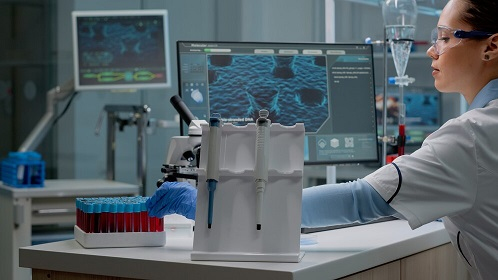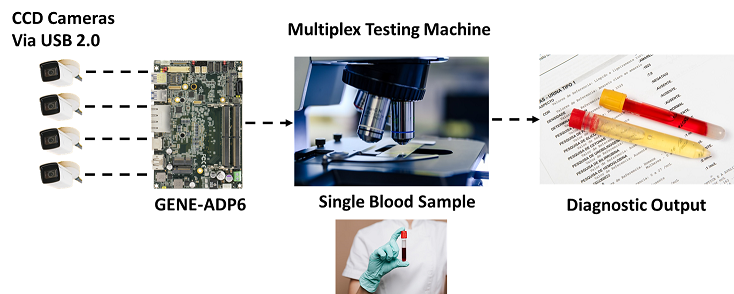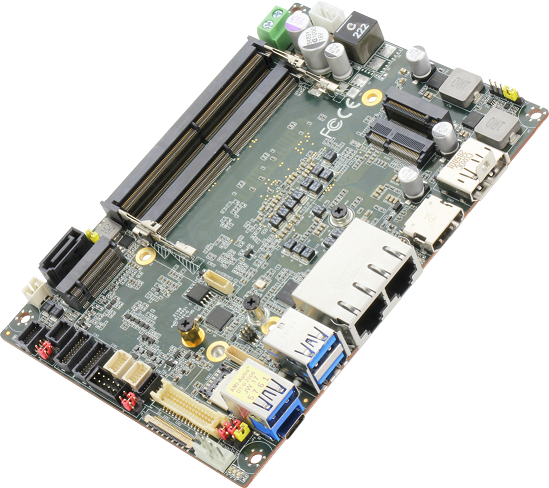案例分享 - 利用GENE-ADP6使血液分析更快、更高效。
The in vitro diagnostics (IVD) industry has seen rapid growth in recent years, with substantial investment encouraged by impressive breakthroughs in the ability to not only diagnose diseases, but also detect risk factors for disease using biomarker analysis. Additionally, the advancement of IVD technology has the potential to mitigate errors which commonly occur during the analytical phase of testing, which are primarily caused by human error. It is therefore vital for IVD equipment to constantly innovate and improve to make blood testing more accurate and efficient.
A leader in the European IVD market wanted to upgrade their multiplex testing machines, used to perform a wide array of blood analysis functions such as immunoassay, clinical chemistry, and molecular testing. However, there were several key attributes the company felt the single-board-computer used to power such sophisticated machinery needed to have.

Project Requirements
The first, and most important of the IVD provider’s needs was the computing power of the board. Due to the vast volume of data processed during blood sample analysis, it was imperative that the solution chosen have exceptional computing performance to ensure thousands of tests could be performed per hour, while still maintaining accurate data output.
Secondly, the customer required a board with a small form factor, so it could be deployed within a larger mechanical unit. Given the number of samples a benchtop laboratory analyzer is expected to process, ensuring sufficient space was maintained was important.
Lastly, the company required a board with an I/O compatible with other components used in their machinery, specifically charge-coupled device (CCD) cameras. Therefore, multiple internal USB ports were a prerequisite for any solution to qualify as suitable.
Application Architecture

This IVD giant had utilized AAEON SBCs in previous models of their testing equipment, and so they were confident in AAEON’s ability to produce high-quality boards to their project specifications. Being familiar with AAEON’s range of SBCs, they singled out the new GENE-ADP6 to power their newest model of multiplex testing machine.
The GENE-ADP6, equipped with 12th Generation Intel® Core™ processors (formerly Alder Lake), was installed as part of a larger mechanical unit, in which blood samples were placed and analyzed on-board using chemiluminescence as a measurement principle for disease markers. CCD cameras connected to the GENE-ADP6 via its four USB 2.0 ports were used to convey the information captured from light emissions and provide an output of the results. Using this method, multiple tests could be completed using a smaller blood sample, dramatically increasing the efficiency of the blood analysis process.
Why the GENE-ADP6?

High-Powered Computing
Powered by the 12th Generation Intel® Core™ i3-1220PE processor, the GENE-ADP6 contained ample computing power through the CPU’s performance hybrid architecture, which provides eight cores (four performance-cores, four efficient-cores) and 12 threads. This allowed the CPU application to dedicate maximum computing power to the most intensive, single-threaded workloads via its performance cores, while maintaining energy-efficiency by having efficient cores focus on multi-threaded throughput. In addition to this, the GENE-ADP6’s support for 64GB of DDR5 4800MHz system memory enabled exceptional bandwidth to ensure high-speed connectivity between the GENE-ADP6 and the CCD cameras connected to it.
Small Form Factor, Functional Suitability
Despite its excellent computing performance, the GENE-ADP6 measures just 5.75” x 4” (146mm x 101.7mm), making it ideal for the customer’s need for a small solution to fit within their multiplex testing machines. The choice to opt for the smallest possible board did not limit the company’s options when it came to functionality however, with the GENE-ADP6 seemingly tailor-made for their needs.
With four internal USB 2.0, three external USB 3.2 Gen 2, and dual 2.5GbE/1GbE ethernet ports, the GENE-ADP6 was able to achieve exceptionally fast connectivity, with the aid of the board’s DDR5 system memory. Consequently, the customer’s multiplex testing machines were able to support the CCD cameras needed for the machine to capture the light emissions it needed to in order to analyze blood samples, with the added benefit of the process being faster and more accurate.
Impact
The success of this application opens the door for the GENE-ADP6 to be deployed in other smart healthcare solutions, with its configuration of functions conducive to channeling the power of AI even within space-limited environments. An example of these functions is its display interface, featuring a HDMI 2.1 port supporting up to 8K display resolution, along with DP 1.4a, LVDS, and an additional USB Type-C port. These functions, combined with the board’s compatibility with Intel® UHD Graphics for 12th Gen Intel® Processors, lend themselves to applications such as diagnostic imaging and more.
